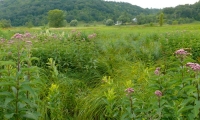Sedge meadows are understood to be open communities of wet soils, where a majority of the plants present are sedges (compared to grasses in a standard meadow) – for more information on sedges, read this past blog written by land steward Joel. Similar plant communities, in terms of moisture in the soil, are fens and bogs. Sedge meadows are found throughout the state and are located in areas where it may flood in the spring but generally lies just above the permanent water table. You can find these plant communities in extinct lake beds and around the shores and banks of existing lakes and streams. They can also be considered a transition habitat between aquatic and upland habitats. Before European settlement in Wisconsin, sedge meadows made up 3.24% of the land surface in the state or 1.134 million acres.
During Curtis' research of sedge meadows, he found seven families of plants present with the top three being Compositae (flowereing plants), Cyperaceae (sedges), and Gramineae (grasses) with flowering plants and sedges being the two dominate families. Like other open communities, a majority of the flowering plants bloom in late summer to early fall with only 12.5-25% blooming in the spring.
But what makes sedge meadows so interesting? Well, let me tell you.
 If you were to walk through a sedge meadow where Carex stricta (tussock sedge) was in abundance, you would find yourself walking on very bumpy "ground." That is because tussock sedge forms a mass of dead leaves and matted down roots that forms a fibrous peat. This mound of peat is known as a tussock (this is what the sedge is named after). This adaptation is very necessary when water levels are high during floods, because the leaves of the sedge will still be above the water level. This adaptation sometimes leads to monocultures of tussock sedge in certain, rare, situations. This can happen if a flood lingers for too long and drowns out other plants, or if the proximity of each tussock is so close that nothing else can grow in the spaces.
If you were to walk through a sedge meadow where Carex stricta (tussock sedge) was in abundance, you would find yourself walking on very bumpy "ground." That is because tussock sedge forms a mass of dead leaves and matted down roots that forms a fibrous peat. This mound of peat is known as a tussock (this is what the sedge is named after). This adaptation is very necessary when water levels are high during floods, because the leaves of the sedge will still be above the water level. This adaptation sometimes leads to monocultures of tussock sedge in certain, rare, situations. This can happen if a flood lingers for too long and drowns out other plants, or if the proximity of each tussock is so close that nothing else can grow in the spaces.
These plant communities aren't only great for observing flowers in the summer and fall, they are also important habitat for wildlife such as sandhill cranes, ring-necked pheasants, white-tail deer, mink and the fox.
If you want more information, I encourage you to stop by any of our branches and talk to one of the land stewards, or volunteer during a land stewardship drop-in time. Or just head out on your own to explore one of these amazing plant communities right here in our state. Scuppernong State Natural Area (Eagle, WI), Cherry Lake Sedge Meadow State Natural Area (Burlington, WI), and Lulu Lake State Natural Area (East Troy, WI) are just some of the many locations where you can find sedge meadows.
Photo credit:
www.lakeandwetlandecosystems.com/plants/grass-like-plants/tussock-sedge-carex-stricta/
www.prairiehaven.com/?page_id=22110





